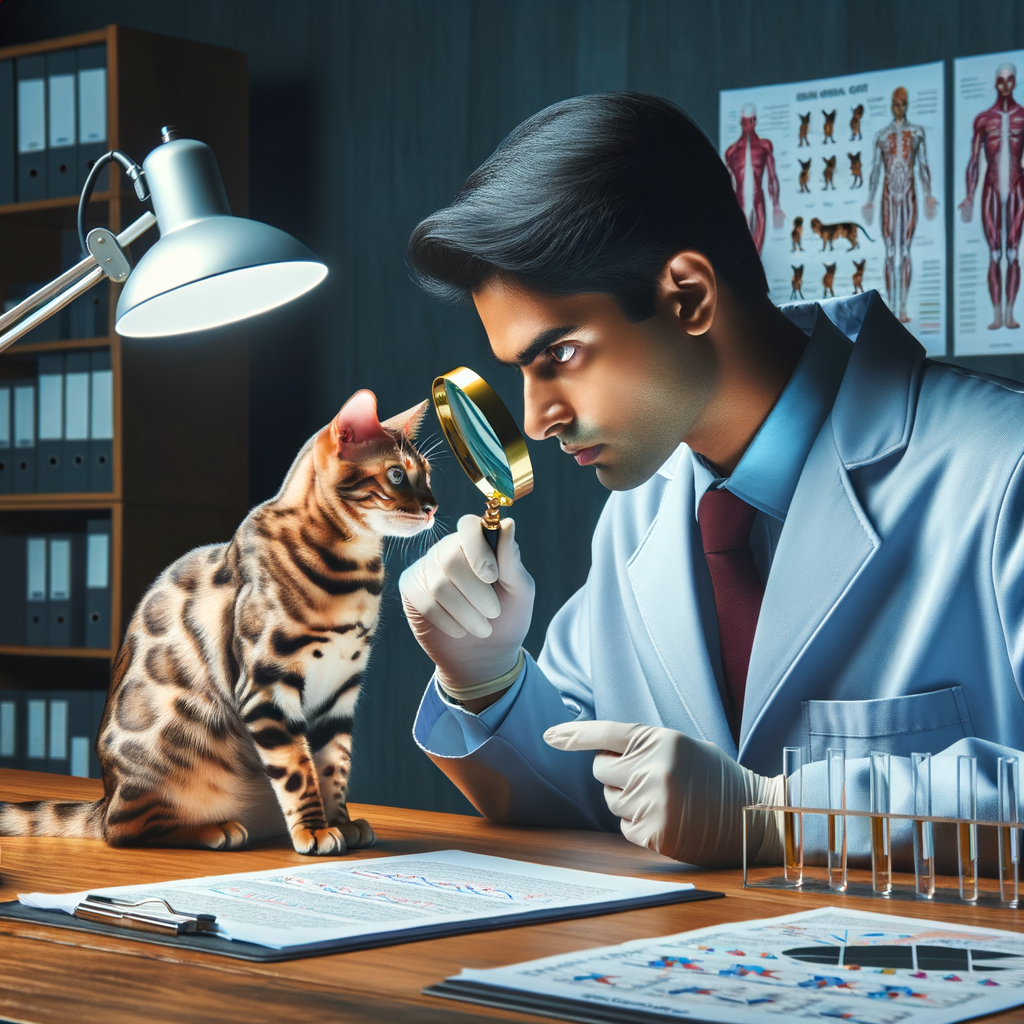
Introduction to Bengal Cat Breeding
- Overview of Bengal Cats
Bengal cats are a unique and beautiful breed known for their wild appearance and friendly nature. They have a striking coat with spots or marbling, making them look like tiny leopards. Bengals are active, playful, and intelligent, making them great pets for families.
- Importance of Genetics in Breeding Bengal Cats
Good genetics ensure that the cats are healthy and have the desired traits. Breeders must understand the genetic makeup of their cats to avoid health issues and maintain the breed’s quality. By focusing on genetics, breeders can produce Bengal cats with beautiful coats, good temperaments, and strong health.
Bengal Cat Genetics
Genetic Traits in Bengal Cats
- Physical traits: Bengal cats have a distinct appearance. They often have a sleek, muscular body. Their coat is usually short and dense, with beautiful patterns. These patterns can be spotted or marbled. Their eyes are large and expressive, often in shades of green or gold.
- Behavioral traits: Bengal cats are very active and playful. They love to climb and explore. They are also known for being intelligent and curious. Some Bengal cats even enjoy playing in water. They are social and often form strong bonds with their owners.
| Trait | Description |
|---|---|
| Physical Traits | Muscular body, short dense coat, spotted or marbled patterns, large expressive eyes. |
| Behavioral Traits | Active, playful, intelligent, curious, enjoys water, social. |
Bengal Cat Hereditary Traits
- Coat Patterns: Bengal cats are famous for their beautiful coats. They have two main patterns: spotted and marbled.
- Spotted: These cats have spots that look like leopard spots. The spots can be large or small and are usually dark brown or black.
- Marbled: This pattern looks like swirls or waves on the cat’s coat. It’s unique and very eye-catching.
Both patterns are stunning and make Bengal cats stand out. According to Wikipedia, these patterns are a result of selective breeding.
- Eye Color: Bengal cats often have striking eye colors. Their eyes can be green, gold, or even blue.Green eyes are the most common, but some Bengal cats have golden or even icy blue eyes. The eye color adds to their wild and exotic look.
- Size and Structure: Bengal cats are medium to large in size. They have strong, muscular bodies.
- Weight: Males usually weigh between 10-15 pounds. Females are a bit lighter, weighing around 8-12 pounds.
- Body: They have long, lean bodies with strong muscles. This gives them an athletic look.
Their size and structure make them agile and playful. They are known for their energy and love to climb and jump.
Breeding Bengal Cats for Health
Bengal Cat Genetic Disorders
- Common Genetic Disorders: Bengal cats can suffer from several genetic disorders. Some of the most common include Progressive Retinal Atrophy (PRA), Hypertrophic Cardiomyopathy (HCM), and Pyruvate Kinase Deficiency (PK Deficiency). These conditions can affect a cat’s vision, heart, and blood cells, respectively.
- Preventing Genetic Disorders Through Selective Breeding: Selective breeding is a key strategy to reduce the risk of genetic disorders in Bengal cats. Breeders carefully choose parent cats that do not carry genes for these disorders. This helps ensure healthier kittens. Regular health screenings and genetic tests are essential tools in this process.
| Genetic Disorder | Impact | Prevention |
|---|---|---|
| Progressive Retinal Atrophy (PRA) | Leads to blindness | Genetic testing of breeding cats |
| Hypertrophic Cardiomyopathy (HCM) | Heart disease | Regular heart screenings |
| Pyruvate Kinase Deficiency (PK Deficiency) | Blood cell issues | Genetic testing of breeding cats |
Selective Breeding in Bengal Cats
-
Role of Selective Breeding in Health
By choosing cats with strong genes, breeders can reduce the risk of genetic disorders.
For example, breeders often test for Hypertrophic Cardiomyopathy (HCM), a common heart disease in cats. By selecting cats without this gene, the chances of kittens developing HCM decrease.
Another benefit is improved immune systems. Healthy parents often produce healthy kittens, leading to fewer vet visits and longer lives.
Benefit Explanation Reduced Genetic Disorders Choosing cats without genetic issues lowers the risk of these problems in kittens. Stronger Immune Systems Healthy parents often pass on strong immune systems to their kittens. Longer Lifespans Healthier cats tend to live longer, happier lives. -
Challenges and Ethical Considerations
Selective breeding is not without its challenges and ethical concerns. One major issue is the limited gene pool. Breeding from a small group of cats can lead to inbreeding, which may cause new health problems.
Ethically, breeders must consider the well-being of the cats. Overbreeding can lead to stress and poor health. Give cats time to rest between litters.
Another ethical concern is the purpose of breeding. Breeders should focus on the health and happiness of the cats, not just their appearance. According to animal welfare guidelines, the well-being of the animals should always come first.
While selective breeding can improve the health of Bengal cats, it must be done responsibly. Breeders should always prioritize the cats’ well-being and avoid practices that could harm them.
Bengal Cat Gene Pool
Genetic Diversity in Bengal Cats
- Importance of genetic diversity
Genetic diversity means having many different genes in a population. It helps Bengal cats resist diseases. It also helps them adapt to changes in their environment. Without genetic diversity, cats can have more health problems.
- Strategies to maintain genetic diversity
There are several ways to keep genetic diversity in Bengal cats:
-
- Breeding with different lines: This means using cats from different families to breed. It helps mix up the genes.
- Outcrossing: This is breeding Bengal cats with other types of cats. It adds new genes to the pool.
- Monitoring genetic health: Breeders can use tests to check the genetic health of their cats. This helps them make good breeding choices.
Bengal Cat Breeding Programs
- Role of breeding programs in maintaining healthy Bengal cat population
These programs focus on selecting cats with the best traits. This helps to avoid health problems and ensures that the cats are strong and healthy.
Breeders work hard to make sure that the cats they breed are free from genetic diseases. They do this by testing the cats before breeding them. This helps to keep the Bengal cat population healthy and strong.
- Case study: Successful Bengal cat breeding program
One example of a successful Bengal cat breeding program is the Happy Bengals Cattery. This program has been running for over 10 years. They have bred many healthy and beautiful Bengal cats.
The breeders at Happy Bengals Cattery follow strict guidelines. They test all their cats for genetic diseases. They also make sure that the cats have good temperaments. This means that the cats are friendly and easy to handle.
Happy Bengals Cattery has received many awards for their work. They are known for producing some of the best Bengal cats in the world.
| Breeding Program | Years in Operation | Key Achievements |
|---|---|---|
| Happy Bengals Cattery | 10+ | Awards for Best Bengal Cats, Healthy Cat Population |
The Future of Bengal Cat Breeding
The world of Bengal cat breeding is always changing. Breeders work hard to make sure these cats are healthy and beautiful. Let’s look at some current trends and what the future might hold.
- Current trends in Bengal cat breeding:Today, breeders focus on health and appearance. They want Bengal cats to have strong bodies and beautiful coats. Many breeders also use genetic testing. This helps them avoid health problems. Shows and competitions are popular too. They let breeders show off their best cats.
- Future prospects and challenges:The future looks bright but also has challenges. Breeders will keep using new technology. This can help them make even healthier cats. But there are also challenges. One big challenge is keeping the gene pool diverse. This means having many different cats to breed from. Another challenge is making sure all breeders follow good practices. This helps keep all Bengal cats healthy and happy.
| Trend | Details |
|---|---|
| Health Focus | Using genetic tests to avoid diseases. |
| Appearance | Breeding for beautiful coats and strong bodies. |
| Technology | Using new tools to improve breeding. |
| Gene Pool | Keeping a diverse group of cats for breeding. |






